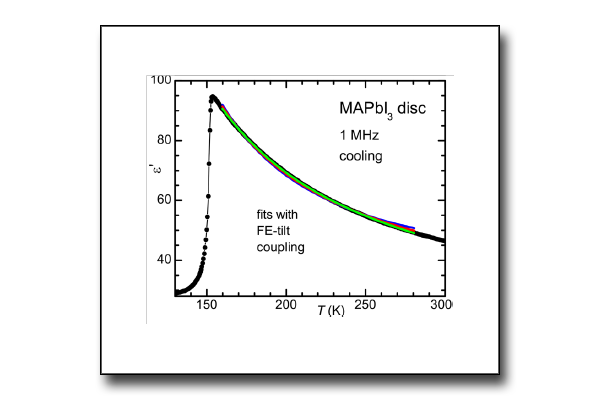Dielectric spectroscopy measures the response of electrical polarization of a medium to an applied electrical field. It is used for the characterization of polar materials (ferroelectrics, relaxor ferroelectrics, multiferroics, photovoltaics, organic-inorganic halide perovskites, electrochemical systems, energy storage capacitor elements) and multiple phase systems (polymer-ceramics composites).
The dielectric spectroscopy laboratory has two main facilities: one for larger samples (typically bars a few cm length and about 1 mm thickness) which consists of a Delta Design chamber (90 – 570 K) and a HP LCR/HP Impedance Bridge (20 Hz- 40 MHz) . The measurements are carried out in air.
Another facility consists of a Linkam temperature controlled probe stage (90 – 870 K, 20 Hz- 40 MHz) where the measurements can be carried out also in inert nitrogen atmosphere, on samples which are typically discs with diameter below 12 mm and thickness around 0.5 mm.
The dielectric permittivity as a function of frequency and temperature and/or the piezoelectric constants are measured on capacitors formed by metallizing a couple of parallel surfaces of the samples.
Measurements of dielectric permittivity are made also on thin films with parallel electrode configuration or in-plane surface capacitors.
It is possible to study all dipolar defects and excitations, the mobility of atoms (diffusion, trapping, defect reorientation, tunneling, cooperative motion etc.), polarons, free charges, and ferroelectric phase transitions and domain wall movements.
The dielectric spectroscopy technique is used for the characterization of ferroelectric/antiferroelectric and relaxor materials, organic-inorganic halide perovskites, piezoelectric/polymer composites, heterogeneous dielectric materials, thin films and heterostructures.
For example in the case of organic-inorganic halide perovskites, the dielectric permittivity vs temperature measurement reveals the phase transitions between different phases. The measurement of dielectric losses reveals anomalies related to the relaxation of the walls between the different variants of structural domains.


 English (UK)
English (UK)  Italiano (Italia)
Italiano (Italia)